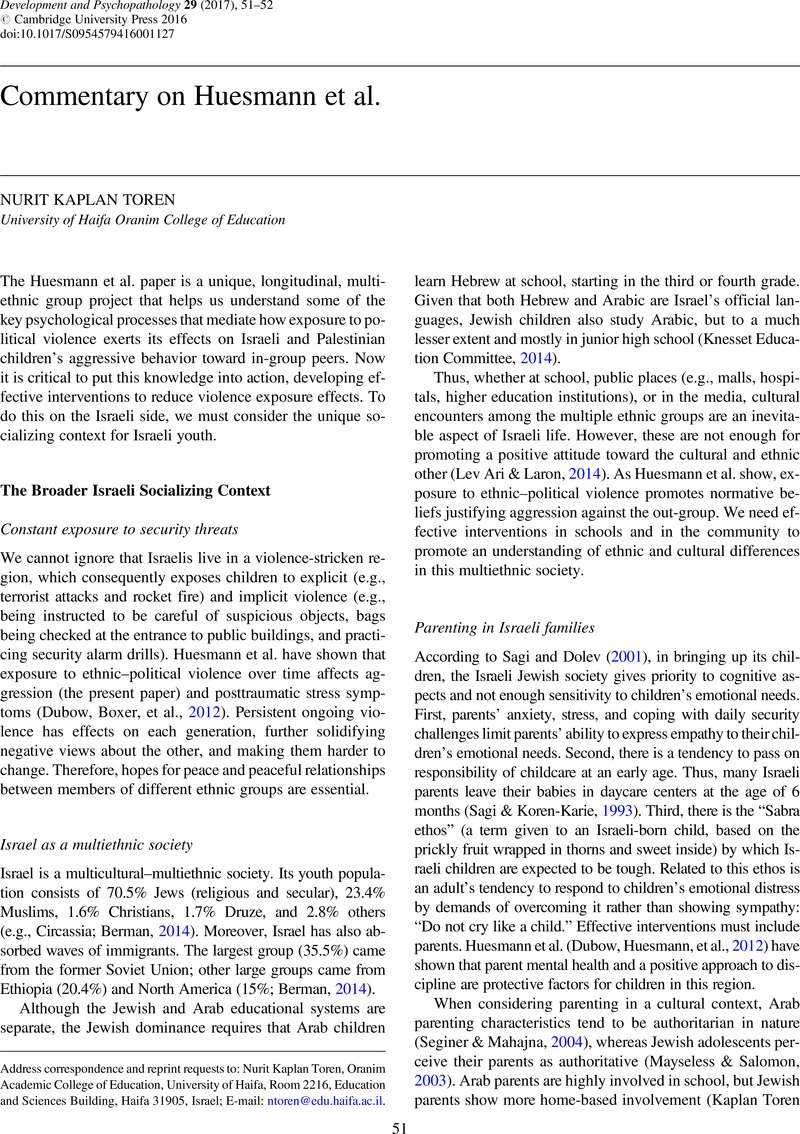No CrossRef data available.
Article contents
Commentary on Huesmann et al.
Published online by Cambridge University Press: 21 November 2016
Abstract
An abstract is not available for this content so a preview has been provided. Please use the Get access link above for information on how to access this content.

- Type
- Special Section Articles
- Information
- Copyright
- Copyright © Cambridge University Press 2016
References
Benish-Weisman, M. (2015). The interplay between values and aggression in adolescence: A longitudinal study. Developmental Psychology, 51, 677–687.CrossRefGoogle ScholarPubMed
Berman, Z. (Ed.) (2014). Children in Israel yearbook. Jerusalem: Israel National Council for the Child.Google Scholar
Dar, Y., & Kimhi, S. (2001). Military service and self-perceived maturation among Israeli youth. Journal of Youth and Adolescence, 30, 427–448.CrossRefGoogle Scholar
Dubow, E. F., Boxer, L. R., Huesmann, L. R., Landau, S., Dvir, S., Shikaki, K., & Ginges, J. (2012). Cumulative effects of exposure to violence on post-traumatic stress in Palestinian and Israeli youth. Journal of Clinical Child and Adolescent Psychology, 41, 837–844.CrossRefGoogle ScholarPubMed
Dubow, E. F., Huesmann, L. R., Boxer, L. S., Dvir, S., Shikaki, K., & Ginges, J. (2012). Exposure to political conflict and violence and post-traumatic stress in Middle East youth: Protective factors. Journal of Clinical Child and Adolescent Psychology, 41, 402–416.CrossRefGoogle ScholarPubMed
Harel, Y., Kanny, D., & Rahav, G. (1997). Youth in Israel: Health behaviors in school-age children: A World Health Organization cross-national study. Jerusalem: Joint Brookdale Institute.Google Scholar
Kaplan Toren, N., & Kumar, R. (2014). Arabs’ and Jews’ students’ similarity and differences perceptions of parents’ educational involvement and its effect on students functioning in school. Paper presented at “Not in My Backyard” conference on cultural inclusion and diversity in educational and social systems, Israel.Google Scholar
Knesset Education Committee (2014). Teaching Arabic language and culture for primary school students. Retrieved from http://main.knesset.gov.il/Activity/committees/Education/News/Pages/13052014.aspx
Google Scholar
Lev Ari, L., & Laron, D. (2014). Intercultural learning in graduate studies at an Israeli college of education: Attitudes toward multiculturalism among Jewish and Arab students. Higher Education, 68, 243–263.Google Scholar
Magen, Z. (1998). Exploring adolescent happiness: Commitment, purpose, and fulfillment. Thousand Oaks, CA: Sage.Google Scholar
Mayseless, O., & Salomon, G. (2003). Dialectic contradictions in the experiences of Israeli Jewish adolescents. In Pajares, F. & Urdan, T. (Eds.), International perspectives on adolescence (pp. 151–173). Charlotte, NC: Information Age.Google Scholar
Sagi, A., & Dolev, S. (2001). Parents, educational settings and children in Israel: “Sweet and Sour.”
Megamot Behavioral Sciences Journal, 41, 195–217. [in Hebrew]Google Scholar
Sagi, A., & Koren-Karie, N. (1993). Daycare centers in Israel: An overview. In Cochran, M. (Ed.), International handbook of daycare policies and programs (pp. 269–290). New York: Greenwood.Google Scholar
Seginer, R. (2009). Future orientation developmental and ecological perspectives. New York: Springer.Google Scholar
Seginer, R. (1996). Jews-Arabs relationships in future perspective: Jews and Arabs future orientation—1984, 1989, 1995. Eunim Bechinuch, 1, 89–105. [in Hebrew]Google Scholar
Seginer, S., & Mahajna, S. (2004). How the future orientation of traditional Israeli Arab girls links beliefs about women's role and academic achievement. Psychology of Women Quarterly, 28, 122–135.CrossRefGoogle Scholar





Target article
Children's exposure to violent political conflict stimulates aggression at peers by increasing emotional distress, aggressive script rehearsal, and normative beliefs favoring aggression
Related commentaries (1)
Commentary on Huesmann et al.